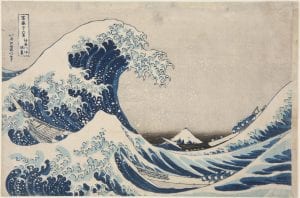Kitagawa Utamaro Collection
Fujin Sōgaku Jittai (婦人相学十躰)
"Ten physiognomies of women") and Fujo Ninsō Juppin (婦女人相十品, "Ten classes of women's physiognomy")
PUBLISHED BY: c. 1792–93
FORMAT: The prints are ōkubi
bijin-ga "large-head" bust portraits of female beauties
in ōban-size (about 25 by 36 centimetres, 10in ×14in).
NOTES: Only five prints from one series and four from the other survive, and
one print appears in both series, so that eight distinct prints are
known. The two series may have been made up of the same prints, or they
may have been the same series with a title change partway through
publication.
Uwaki no Sō (浮気之相)
Fancy Free
A young woman—most likely in her 20s—is dressed carelessly in a yukata, with her head turned behind her, looking outside the picture. She is probably returning from a sentō bath. She wipes her hands with a cloth draped over her right shoulder.
In modern Japanese, uwaki usually means "sexual unfaithfulness"; less often it means "lively" or "frivolous", or indicates a showy disposition. In Utamaro's time the word referred to a flighty personality apt to follow fads and fashions.
The woman has a kanzashi hairpin and a comb placed casually in her hair. She has her mouth open slightly, as if she were about to speak, and has a seductive look in her eyes. The background is dusted with muscovite, a variety of mica, which produces a glittering effect. The vegetable pigments have faded from their original colours; the kimono was most likely a pale blue.
Omoshiroki Sō (面白キ相)
"The Interesting Type"
A woman looks in a mirror in her right hand. She examines her teeth, which have been blackened with ohaguro, which normally only married women applied. Women applying ohaguro are normally depicted with the mirror in the left hand and the ohaguro brush in the right.Utamaro uses a limited number of colours in this print, which gives the impression of a dim interior scene.
Tabako no Kemuri o Fuku Onna 煙草の煙を吹く女
"Woman blowing tobacco smoke"
Utamaro depicts a young woman holding a kiseru tobacco pipe. She sits in a decadent posture with her kimono open, exposing her breasts, and her hair is coming untied. The pipe rests on her fourth and fifth fingers, with her thumb at the end on her index and middle finger holding it on top. She blows a puff of smoke rendered with karasuri embossing against the mica-dusted background.Uchiwa o Sakasa ni Motsu Onna 団扇を逆さに持つ女
"Woman holding a hand-fan upside-down"
A young woman holds a round uchiwa hand fan upside-down with both hands, possible turning it in circles; she appears lost in thought.A finely-patterned obi sash that wraps around her light, summer haori, a kimono-like jacket. The grey haori is of silk gauze, and its sleeves have slid down the woman's arms, revealing their white skin at the centre of the composition. Five-leafed ivy mon crests adorn the kimono, as well as a three-leafed ivy crest on the fan, signifying this is Naniwa O-Kita, a famed teahouse girl who appeared in many prints by Utamaro and others.
Yubi-ori Kazoeru Onna 指折り数える女
"Woman counting with her fingers"
A woman counts something on the fingers of her right hand. Her left hand is on her obi sash, and her posture and facial expression suggest she is thinking seriously about something.
In Japanese yubi-ori kazoeru (指折り数える, "count by bending fingers") refers to a style of finger counting
by which a person begins with the hand open and counts by folding
inward first the thumb ("one"), then from the index finger to the baby
finger.
Sensu o Mochi Higasa o Sasu Onna 扇子を持ち日傘をさす女
"Woman holding a hand-fan and parasol"
Fumi Yomu Onna 文読む女
"Woman reading a letter"
In , a woman reads what is almost certainly a love letter, per the expectations in ukiyo-e. Expectations would also predict the recipient to be a courtesan or young girl, but the woman's shaven eyebrows and teeth blackened with ohaguro show that she is married. She holds the letter close to her eyes and probably reads it secretly and in low light. The arch in her posture and her squeezing grip on the letter suggest a conflicted emotional state brought on by a likely tangled relationship.Popen o Fuku Musume ポペンを吹く娘
"Young woman blowing a poppen glass"
A young woman plays with a popen—a glass toy that changes sounds depending on whether the breath is blown or sucked through it; the change makes an onomatopoeic po–pen sound. It was an exotic type of toy a sheltered girl from a respectable family could have innocent fun with; she is likely the daughter of a wealthy merchant family. To Japanese art historian Tadashi Kobayshi, "Utamaro has marvelously captured her just when she seems about to achieve a more mature, voluptuous beauty but has yet to lose the innocence and naïveté of childhood.The young woman wears a furisode—a type of kimono worn by young unmarried women. It has a design of scattered cherry blossoms over a red-and-white checkered pattern.
















































